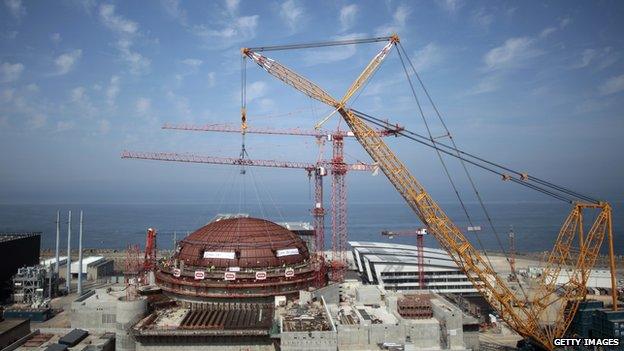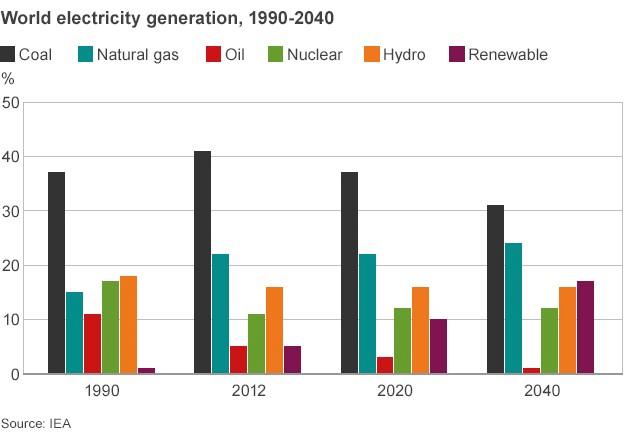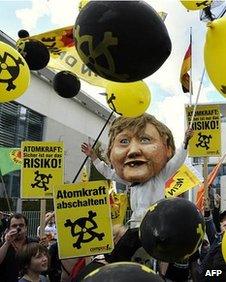Nuclear power: Energy for the future or relic of the past?
- Published

The Flamanville plant is the first new nuclear plant to be built in France for 15 years
Those living in Western Europe could be forgiven for thinking nuclear power is a spent force.
Overwhelming public opposition has forced Italy to abandon any plans for reigniting its nuclear industry, while Germany is pressing ahead with its long-held policy of phasing out all reactors by 2022.
Belgium is following its neighbour's lead, while Spain has no plans to add to its fleet of seven plants. Even France, the poster child for nuclear power, has announced plans to reduce drastically its dependency on atomic energy.
Add the fact that four years after the Fukushima disaster none of Japan's 48 reactors are back online, and that nuclear's share of global electricity generation has fallen from 17% to 11% in the past 20 years, and you might assume the industry is in terminal decline.
You would be wrong. Quite wrong.
New nuclear
In fact, according to Dr Jonathan Cobb at the World Nuclear Association (WNA), there are 70 nuclear reactors under construction, "the highest number in 25 years".
There are a further 500 proposed plants - far more than are operating in the world today.
Of course a good many will never see the light of day, but these figures show clearly that governments across the world are looking to nuclear power to solve some of the most pressing dilemmas they face - namely how to meet growing energy demand and increase energy security while reducing the CO2 emissions linked with global warming.
Seen as a proven, low-carbon technology, many view nuclear as a key part of the solution, and none more so than China.

The country is building 27 new reactors and has plans for almost 200 more, according to the WNA. The reason is simple - demand for energy is expected to triple by 2050, so China needs all the power it can get.
Building nuclear plants in China, as well as in some other developing economies, is relatively straightforward. For a start, they are much cheaper to construct - typically between $10bn (£6.5bn) and $15bn - while the state-controlled economy provides the necessary regulatory and financial support.
Such huge capital investments need to be underpinned by long-term funding and, as Cecilia Tam at the International Energy Agency says, "China's banks are ready to finance [nuclear power plants]."
A number of countries in the Middle East, including Saudi Arabia and the United Arab Emirates, are also planning to build nuclear reactors, facilitated by strong authoritarian regimes.

Many states in central and Eastern Europe are also looking to increase their nuclear capacity, including Hungary, Romania and Ukraine, while Poland and Turkey plan to enter the nuclear age for the first time.
Many of these countries are heavily reliant on coal and need to find cleaner energy sources to reduce CO2 emissions.
And as Peter Osbaldstone at energy consultants Wood Mackenzie says, nuclear power is seen as "a very real opportunity to provide energy diversity, particularly given their dependence on Russian gas".
Big commitment
The picture in the free markets of Western Europe and the United States is very different. Here, even where there is political will, financing is proving a major stumbling block.
Nuclear power plants are mind-bogglingly expensive to build. For example, operator EDF Energy estimates its new Hinkley Point plant in the UK will cost $24bn, with the European Union putting the figure at closer to $36bn.
No private company is willing or able to make that kind of financial commitment on its own, particularly given it will be almost 10 years before the plant is operational and can begin generating a cash return.

Nuclear waste

Only temporary waste storage facilities exist, for example in Connecticut
About 90% of a plant's nuclear waste, called "low-level waste", contains 1% of its radioactive content. This can be handled easily without shielding
Some 3% of a plant's waste, known as "high-level waste", contains 95% of its radioactive content
The high-level waste generated over the 60-year lifespan of a typical plant can fit into an Olympic-sized swimming pool
High-level waste takes several thousand years to decay before its radioactivity level reaches that of the uranium first used to fuel nuclear fission
There is no permanent facility for storing high-level waste anywhere in the world.
Source: World Nuclear Association

After years of negotiations with various energy groups, the UK government finally managed to convince EDF to invest, but only after it guaranteed the company a set price for the electricity the plant produces, even if this is higher than the open market price at the time. Even then, EDF only committed once it had secured Chinese backing. And even now final investment decisions have not been submitted.
And the UK is not alone. In France, the Flamanville plant, the first in the country for 15 years, is already three years late and way over budget, while Finland's new reactor is also well overdue and has cost billions more than expected.
Mr Cobb says all these reactors are the first to use new EPR technology that incorporates "lots of new innovations" - teething problems that should be ironed out by the time construction on newer plants begins.
But as Mr Osbaldstone says, these are "not great adverts for [EPR]".
In the US, billions of dollars of government loan guarantees were needed to fund new power plants, with all five already suffering significant delays. Here, the government is also working closely with the industry to develop smaller, modular reactors designed to be more flexible and cost significantly less than traditional designs.
But for now, "the harshest test for nuclear technology is simply being able to deliver plants on time and on budget," says Mr Osbaldstone.
Counting costs
Once a nuclear power station has been built, it is relatively cheap to run. There is plenty of uranium in the world and, in terms of cost per unit, it is cheaper than fossil fuels.

But factoring in the costs of construction, nuclear is far from the cheapest energy source available. In fact, in Europe it is more expensive than coal and gas, even when factoring in a price for carbon. It is also more expensive than onshore wind and, in many countries, solar, and the cost of these renewable energies is coming down fast.

Nuclear free zone: Germany

There is widespread public support for phasing out nuclear power in Germany
The German government took the decision to phase out nuclear power in 2000, setting a date of 2022 for the final reactor shutdown. The ruling was driven by the Greens but it now enjoys cross-party support, so there will be no policy change, according to Prof Claudia Kemfert at the German Institute for Economic Research.
It also enjoys the support of the vast majority of Germans.
The government expects to make up the shortfall in power as a result of shutting off nuclear "primarily with renewable energy", says Prof Kemfert. This, together with gas-fired power plants, should supply the country's energy needs, it believes.
Energy efficiencies, demand-side management and energy storage will also play an important role in keeping the lights on.
The move away from nuclear has not been managed as smoothly as had been hoped - there has been an increase in coal use and electricity bills have risen due to renewable energy subsidies - but Germany believes this short-term pain is a small price to pay for a cheap, clean energy supply long into the future.

Inherent risks
Of course finance is not the only risk associated with nuclear power. The Fukushima disaster is a timely reminder, coming 25 years after Chernobyl, external, of the inherent dangers involved in harnessing nuclear power. Technological advances have made nuclear fission safer, but the risk of a reactor leak can never be discounted completely.
Fukushima has also drawn attention away from nuclear waste. To this day there remains no permanent facility for storing spent radioactive fuel anywhere in the world.
"If the industry could find a final solution [to storing waste], it would increase public acceptance of nuclear power," says Ms Tam.
But such a solution is unlikely any time soon - sites have been identified in Sweden and Finland, but these should be opened only in "the next decade or two", says Mr Cobb.
Environmentalists argue that given the risks and financial costs involved, investing in renewables is the more sensible option. They may just have a point.